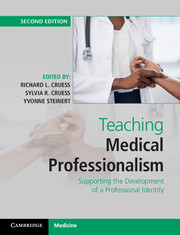Introduction
Published online by Cambridge University Press: 05 April 2016
Summary
When the first edition of Teaching Medical Professionalism1 was published, considerable experience on teaching and assessing professionalism had been developed in medicine's educational establishments. The book was therefore based upon a body of knowledge that existed, and the authors formed their recommendations upon their own experiences and that of others working in the field. The emphasis has recently shifted from teaching professionalism to supporting professional identity formation,2–4 despite a lack of literature outlining how professional identity formation can be supported throughout the continuum of medical education. It is our hope that this book can partially fill the void, as it brings together educators and researchers who have focused on the subject of professional identity formation in medicine.
The idea that physicians actually have a professional identity is not new. In 1957, Merton published one of the first studies of the sociology of medical education.5 In the introduction to the book, Merton stated (p. 5) that medical education has a dual purpose: “to shape the novice into the effective practitioner of medicine, to give him the best available knowledge and skills, and to provide him with a professional identity so that he comes to think, act, and feel like a physician.”5 Through the ages, great emphasis has been placed on ensuring that medical graduates possess the requisite knowledge and skills, using increasingly sophisticated methods of teaching and assessment.6
Until recently, it was assumed that medical students and residents would acquire their professional identities by patterning their behavior after respected role models.7 The desired identities were encompassed in the concept of professionalism, and physicians were expected to behave like professionals. While there were frequent references in the literature to professionalism, it was not addressed explicitly, being mainly taught in the informal curriculum.
There is agreement that this historic system functioned reasonably well, as long as a homogeneous medical profession that was largely male and made up of members of the dominant social group served a comparably homogeneous population.7 There was also general agreement between medicine and society on shared values. The world changed after World War II. As the medical profession and the society that it served became wonderfully diverse, passing on the traditional values cherished by both the profession and society became more difficult. This was occurring as medicine and systems of healthcare delivery became more complex.
- Type
- Chapter
- Information
- Teaching Medical ProfessionalismSupporting the Development of a Professional Identity, pp. 1 - 4Publisher: Cambridge University PressPrint publication year: 2016
References
- 1
- Cited by



